HMS Gloucester (1654) facts for kids
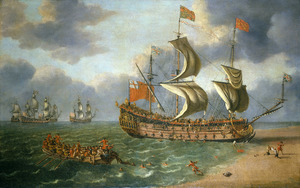
Johan Danckerts (c. 1682), The Wreck of the Gloucester off Yarmouth, 6 May 1682, Royal Museums Greenwich
|
|
Quick facts for kids History |
|
|---|---|
| Name | Gloucester |
| Ordered | December 1652 |
| Builder | Matthew Graves, Limehouse |
| Cost | £5,473 |
| Launched | probably March 1654 |
| Commissioned | Margate |
| Owner | Royal Navy |
| Acquired | 1660 |
| Renamed | Gloucester |
| Fate | Wrecked, 6 May 1682 |
| General characteristics | |
| Class and type | Speaker-class (third rate) |
| Tons burthen | 75511⁄94 (bm) |
| Length | 117 ft (35.7 m) (keel) |
| Beam | 34 ft 10 in (10.6 m) |
| Depth of hold | 14 ft 6 in (4.4 m) |
| Sail plan | Full-rigged ship |
| Complement | 50 guns (as built); 60 guns (1677) |
The Gloucester (sometimes spelled Glocester) was a powerful warship. It was a type of ship called a frigate, which was a fast and strong warship. It became part of the Royal Navy in 1660. The ship was ordered in 1652 and built in Limehouse, East London. It was launched in 1654.
In 1682, the Gloucester was carrying James Stuart, Duke of York, who would later become King James II. The ship hit a sandbank off the coast of Norfolk, England, and quickly sank. The Duke of York was saved, but about 130 to 250 people drowned. Some people believe the Duke's actions delayed the rescue, causing more deaths.
The Gloucester fought in many important battles. These included the Battle of Lowestoft in 1665 and the Four Days' Battle in 1666. It also took part in the St. James's Day Battle in 1666 and the Battle of Solebay in 1672. The ship was rebuilt in 1678 to make it even stronger.
In 2007, divers found the wreck of the Gloucester. They found many items like old clothes, shoes, and tools. Experts say this discovery is one of the most important finds since the Mary Rose was raised in 1982. An exhibition about the Gloucester wreck was held at the Castle Museum in Norwich.
Contents
After the English Civil War ended in 1649, England's new government faced threats from other countries and from supporters of the old king. These groups often attacked English ships. To protect itself, the government decided to make its navy much stronger. They worked hard to improve the navy and ordered many new ships. By 1651, the English navy was almost twice as big as it had been at the end of the war.
The navy helped the government in many ways. It fought against royalist ships that were attacking English trade. It also helped take back important islands like the Isles of Scilly and the Channel Islands. These islands were used by royalist ships as bases. The navy also helped protect supplies sent by sea during the war with Scotland. By 1653, England's navy was a major force in the world.
How Warships Fought: The Line of Battle
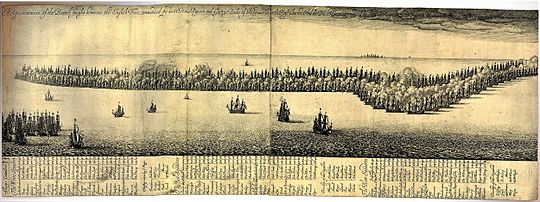
In the 1650s, naval battles were often a messy fight between individual ships. But English sailors realized that firing cannons from the side of many ships at once was much more effective. This meant ships needed to sail close together in a straight line. This tactic was called the line of battle.
Warships like the Gloucester were big and strong enough to be part of this line. They had many cannons on at least two decks. About 100 ships could form a line of battle.
The Dutch navy had many ships, but they were often smaller and not as good for fighting in a line. England ordered 30 new frigates in 1652. One important ship, the Speaker, launched in 1650, became the model for a new group of ships. The Speaker-class ships, built between 1650 and 1654, were about 750 tons and carried 48 to 56 cannons. These new ships made the Dutch navy's older merchant ships less useful in battle. The Speaker-class ships set the standard for many two-deck warships built for the next 150 years.
Building the Gloucester
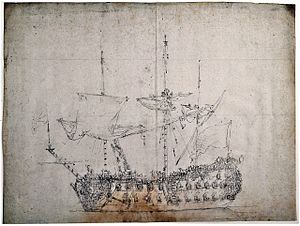
The Gloucester was a Speaker-class ship. It was the first British naval ship named after the city of Gloucester. It was ordered in December 1652 as part of the big expansion of the English navy. The ship was probably launched in March 1654.
Larger warships like the Gloucester were often built in private shipyards. This helped save money and time. The Gloucester cost the navy £5,473. It was built in Limehouse, East London, by Matthew Graves.
The ship was 117 feet (35.7 m) long at its main gun deck. It was 34 feet 10 inches (10.6 m) wide and had a depth of hold of 13 feet 6 inches (4.1 m). The Gloucester weighed 755 tons. When first built, it had 50 guns. By 1667, it carried 57 guns. The ship had a crew of 210 to 340 sailors and officers.
Ship's Service and Battles
First Missions (1654–1658)

The Gloucester began its service in 1654. Its first captain was Benjamin Blake. The ship joined a large expedition to the Caribbean in December 1654. This mission, called the Western Design, aimed to challenge Spanish power in the West Indies. The fleet had 17 warships and 20 transport ships with 3,000 soldiers.
The expedition first tried to land in Hispaniola in April 1655. But the soldiers faced disease and a lack of supplies, so they had to retreat. The fleet then moved to Jamaica and successfully invaded the island, which surrendered in May.
After this, the Gloucester stayed in the Caribbean for a while. In November 1658, the ship was sent to the Sound (a strait between Denmark and Sweden) with 19 other ships. This was to protect English interests after a Dutch fleet defeated the Swedes. The mission faced strong winds and bad weather. The ships had to return home, having achieved little.
Fighting in the Anglo-Dutch Wars
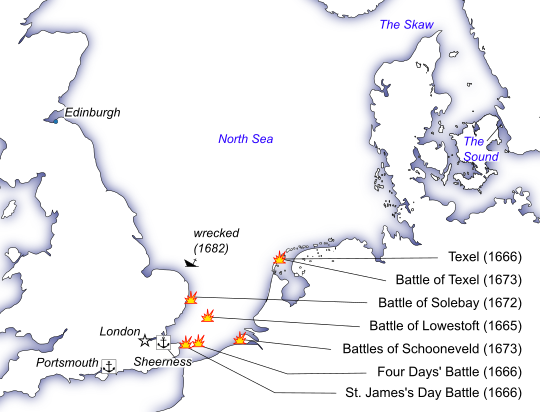
In 1660, the ship was officially renamed HMS Gloucester. It then took part in several major conflicts known as the Anglo-Dutch Wars.
Battle of Lowestoft (1665)
The Gloucester fought in the Battle of Lowestoft on June 3, 1665. This was the first big battle of the Second Anglo-Dutch War. The English fleet, led by James Stuart, Duke of York, fought a Dutch fleet. The English had 100 ships, including 64 warships, and had more firepower.
During the battle, the Dutch flagship exploded, killing their commander. The Dutch fleet then broke apart and tried to escape. By the end of the battle, the English had captured or sunk 17 Dutch ships.
Battles of 1666
In May 1666, the Gloucester, now captained by Robert Clark, fought the Dutch near Texel island. Clark captured seven Dutch ships.
The Gloucester then joined the Four Days' Battle (June 1–4, 1666). This was the longest naval battle in British history. The English lost 10 ships, and the Gloucester was badly damaged. 18 men on board were killed and 27 were wounded.
The Gloucester was quickly repaired. In July 1666, it fought in the St James's Day Battle. The Dutch fleet was weaker and disorganized, and the English won a big victory.
Attack on the Smyrna Fleet (1672)
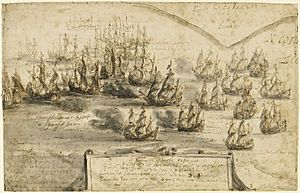
In March 1672, the Gloucester took part in an attack on the Dutch Smyrna convoy in the North Sea. This convoy had six warships and 66 merchant ships. The English captured five merchant ships. The Gloucester disabled and captured a Dutch warship called the Klein Hollandia, which later sank.
Battle of Solebay (1672)
The Gloucester was part of the Blue Squadron during the Battle of Solebay on May 28, 1672. This battle was one of the fiercest in British naval history.

The English and French fleets met off the coast of Suffolk. The Dutch fleet surprised them while many sailors were on shore. The battle was very intense. The Duke of York's ship was so damaged that he had to move to two other ships. The battle ended with no clear winner, but the English had heavy losses.
Battles of Schooneveld and Texel (1673)
The Gloucester fought in the Battles of Schooneveld off the coast of the Netherlands in June 1673. There were two battles, and neither side lost any ships, but many lives were lost.
The Gloucester also took part in the Battle of Texel on August 11, 1673. This was the last battle of the Third Anglo-Dutch War. The English and French fleets tried to destroy the Dutch fleet. The battle was fierce, and many ships were damaged. About 3,000 men were killed. After this battle, the Gloucester was sent to the Mediterranean.
The Final Voyage to Scotland (1682)
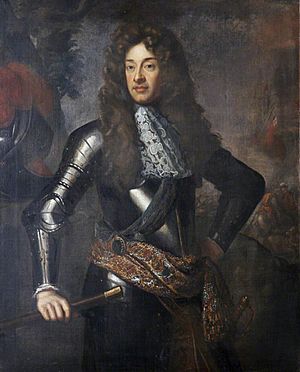
The Gloucester was a very important ship. From 1678 to 1680, it underwent a very expensive and thorough repair at Portsmouth.
In April 1682, the Gloucester was chosen to carry the Duke of York (who would become King James II) and his group to Edinburgh, Scotland. James wanted to finish his business in Scotland and pick up his pregnant wife, Mary of Modena, and his daughter, Anne. He wanted his wife to give birth in England so their child would be an English heir to the throne.
Many important people were on board the Gloucester, including John Churchill, who later became a famous general. The fleet, including the Gloucester and several other warships and royal yachts, left the Kent coast on May 4.
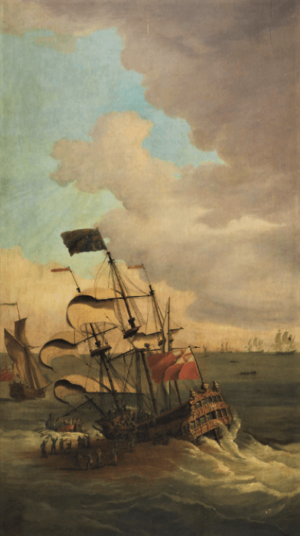
Bad weather forced the Gloucester to stop and anchor during the first night. Three other ships misunderstood the signal and sailed away, never rejoining the fleet.
The Sinking
On the second evening, May 5, 1682, a disagreement happened between the Duke of York and the ship's pilot, James Ayres. Ayres was an experienced navigator and knew about the dangerous sandbanks off the English coast. He wanted to sail closer to the coast to avoid them. The ship's master, Benjamin Holmes, suggested a deeper route. The Duke chose a middle course.
In the early morning of May 6, 1682, strong winds pushed the Gloucester. Around 5:30 AM, the ship hit the Leman and Ower sandbank, about 45 kilometres (28 mi) off Great Yarmouth. The sandbank was hidden in the dark. The ship bounced along the sand, which broke off its rudder and caused water to rush into the hull. Less than an hour after hitting the sandbank, the Gloucester sank.
Rescue Efforts and Aftermath
Thanks to the efforts of Captain Berry, the Duke of York was saved. The ship's boats were lowered, and other ships sent their boats to help. The Duke hesitated to leave the ship, believing it would not sink. He finally left only when it was clear the ship was lost. He also insisted that his strongbox with important papers be loaded first, which delayed the rescue.
Because of naval rules, no one could leave the ship while a member of the royal family was still on board. This delay meant that many people could not escape in time. Between 130 and 250 sailors and passengers lost their lives. Many of the Duke's servants drowned.
The Duke of York finished his journey to Edinburgh on another yacht. He blamed the ship's pilot, James Ayres, for the sinking. Ayres was arrested and imprisoned for a year, but later released.
Discovery of the Wreck
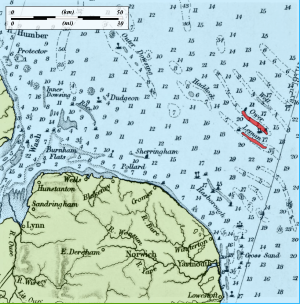
In 2007, after a four-year search, the wreck of HMS Gloucester was found about 28 miles (45 km) off the Norfolk coast. It was found by brothers Julian and Lincoln Barnwell and their diving team. They found many items, including a Royal Navy cannon and an old jug. A pewter teaspoon from 1674 helped them figure out it was the Gloucester. They also found a wine bottle with the family crest of George Legge, an important person on board. Another bottle had the emblem of the Sun Tavern, which supplied the navy. These clues helped confirm the wreck's identity.
Other items found included navigation tools, clothing, shoes, and personal belongings. No human remains were found.
In 2012, the ship's bell was found. It had "1681" carved on it, which confirmed the wreck was the Gloucester. The discovery was announced in 2022. Experts like Claire Jowitt from the University of East Anglia said it was the most important maritime discovery since the Mary Rose was raised in 1982. She said it would change our understanding of 17th-century history.
Exhibition
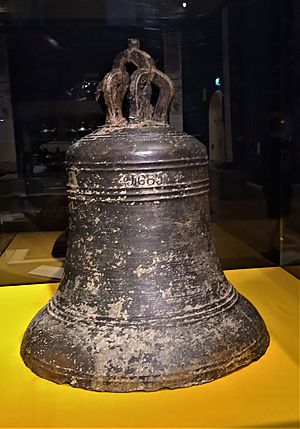
An exhibition called The Last Voyage of the Gloucester: Norfolk’s Royal Shipwreck 1682 was held at the Castle Museum in Norwich. It ran from February 25 to September 10, 2023. The exhibition showed items from the wreck and new information about its history.
Sources
- Jowitt, Claire (2022). "The Last Voyage of the Gloucester (1682): The Politics of a Royal Shipwreck". The English Historical Review 137 (586): 728–762. doi:10.1093/ehr/ceac127.


